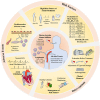Bruton tyrosine kinase inhibitor-related atrial fibrillation and its implications in the treatment of B-cell lymphoma
- PMID: 39131702
- PMCID: PMC11310794
- DOI: 10.3389/fcvm.2024.1408983
Bruton tyrosine kinase inhibitor-related atrial fibrillation and its implications in the treatment of B-cell lymphoma
Abstract
Adverse events of atrial fibrillation (AF) have been commonly reported in lymphoma patients in treating Bruton's tyrosine kinase inhibitors (BTKi). The incidence rate of AF can vary depending on the specific types of BTKi and the patient population. Totally 45 published studies have revealed that the overall incidence rate of AF is 5% (95% CI 4%-7%). By performing a subtype single-rate analysis, the second-generation BTKi shows a lower AF incidence rate and lower cardiovascular toxicity. In the subtype single-rate analysis, we conclude the different AF incidence rates of Ibrutinib (10%, 95% CI 7%-13%), Acalabrutinib (4%, 95% CI 1%-6%), Orelabrutinib (0%, 95% CI 0%-1%), and Zanubrutinib (0%, 95% CI 0%-1%). The comprehensive analysis of AF inspires us to better predict and manage AF and other cardiovascular events in treating lymphoma. Meticulous evaluation, collaboration between cardiologists and hematologists, and discovery of new biomarkers are essential for its management.
Keywords: Bruton tyrosine kinase inhibitors; Ibrutinib; atrial fibrillation; cardiovascular toxicity; lymphoma.
© 2024 Du, Chen, Gu, Wang and Huang.
Conflict of interest statement
The authors declare that the research was conducted in the absence of any commercial or financial relationships that could be construed as a potential conflict of interest.
Figures



Similar articles
-
Zanubrutinib in patients with previously treated B-cell malignancies intolerant of previous Bruton tyrosine kinase inhibitors in the USA: a phase 2, open-label, single-arm study.Lancet Haematol. 2023 Jan;10(1):e35-e45. doi: 10.1016/S2352-3026(22)00320-9. Epub 2022 Nov 16. Lancet Haematol. 2023. PMID: 36400069 Clinical Trial.
-
Ibrutinib and Bruton's Tyrosine Kinase Inhibitors in Chronic Lymphocytic Leukemia: Focus on Atrial Fibrillation and Ventricular Tachyarrhythmias/Sudden Cardiac Death.Chemotherapy. 2023;68(2):61-72. doi: 10.1159/000528019. Epub 2022 Nov 10. Chemotherapy. 2023. PMID: 36366814 Review.
-
Cardiotoxicity from bruton tyrosine kinase inhibitors (BTKi)-an analysis of an administrative health claims database.Cardiooncology. 2024 Jun 1;10(1):33. doi: 10.1186/s40959-024-00237-x. Cardiooncology. 2024. PMID: 38824606 Free PMC article.
-
Risk of New-Onset Atrial Fibrillation Associated With Targeted Treatment of Lymphoma.JACC Adv. 2023 Sep 12;2(8):100602. doi: 10.1016/j.jacadv.2023.100602. eCollection 2023 Oct. JACC Adv. 2023. PMID: 38938336 Free PMC article.
-
Zanubrutinib in lymphoproliferative disorders: a comprehensive review.Ther Adv Hematol. 2022 May 27;13:20406207221093980. doi: 10.1177/20406207221093980. eCollection 2022. Ther Adv Hematol. 2022. PMID: 35651781 Free PMC article. Review.
References
Publication types
LinkOut - more resources
Full Text Sources

